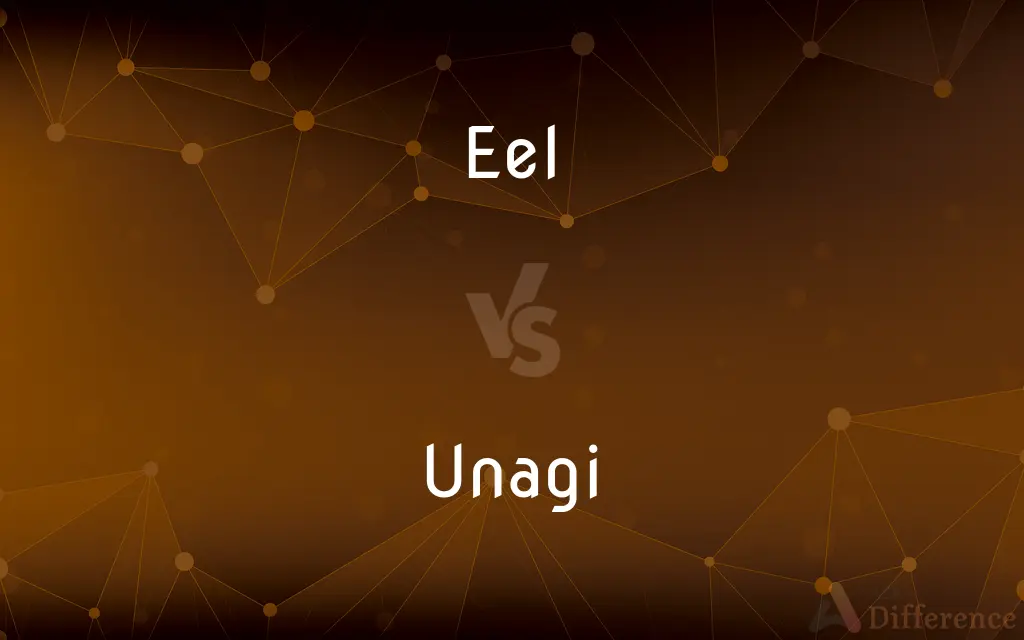Eel vs. Unagi — What's the Difference?
By Tayyaba Rehman & Urooj Arif — Updated on April 26, 2024
Eels are a broad category of elongated, snake-like fish found in both freshwater and marine environments, while unagi specifically refers to the freshwater eel species popular in Japanese cuisine.

Difference Between Eel and Unagi
Table of Contents
ADVERTISEMENT
Key Differences
Eels encompass a wide variety of species within the order Anguilliformes, which includes over 800 different types, thriving in diverse aquatic habitats. On the other hand, unagi is a term used exclusively in Japanese to describe the freshwater eel, primarily Anguilla japonica, which is a single species commonly used in dishes such as sushi and kabayaki.
Eels can be found globally, inhabiting both shallow waters of rivers and lakes and the deep sea. In contrast, unagi refers specifically to those eels that live in freshwater rivers of Japan, crucial to the species' life cycle involving migration between marine and freshwater environments.
While eels in general have varied diets based on their species and habitat, ranging from small fish to crustaceans, unagi typically feeds on a more specialized diet, including worms and smaller fish, which contributes to its distinct taste when cooked.
The term eel is used in a broad sense and does not imply a specific culinary use, whereas unagi is highly regarded in Japanese cuisine for its rich, fatty texture and is often grilled with a glazing of soy-based sauce.
In cultural significance, eels are often regarded differently across the world, with varying levels of appreciation and culinary use. Conversely, unagi holds a special place in Japanese culture, celebrated annually on the Day of the Ox in summer, where it is eaten to promote vitality and health.
ADVERTISEMENT
Comparison Chart
Definition
A fish from the order Anguilliformes, widely diverse.
A specific freshwater eel, Anguilla japonica, used in Japanese cuisine.
Habitat
Both freshwater and marine environments.
Strictly freshwater rivers in Japan.
Culinary Use
Varied, not specific to any particular cuisine.
Primarily in Japanese cuisine, especially sushi and kabayaki.
Diet
Ranges from fish to crustaceans depending on species.
Mostly worms and small fish.
Cultural Significance
Varies widely across different cultures.
Highly prized in Japan, associated with health and vitality.
Compare with Definitions
Eel
Any fish belonging to the order Anguilliformes, characterized by their elongated bodies.
The marine biologist explained that eels can be found in both fresh and salt water.
Unagi
Often highlighted in Japanese food culture for its nutritional benefits, including high protein content.
Besides its flavor, unagi is also prized for its health benefits.
Eel
A slippery, elongated fish, often misunderstood due to its snake-like appearance.
Children at the aquarium were fascinated by the eel's smooth, gliding movements.
Unagi
A culinary term in Japan, representing a dish where the eel is grilled and coated with a sweet soy-based sauce.
I ordered unagi donburi for lunch, which was extremely satisfying.
Eel
A type of fish known for its ability to generate an electric charge, applicable to some species.
The electric eel is capable of producing a shock that can be quite powerful.
Unagi
Associated with the annual summer Day of the Ox, where it's eaten to beat fatigue.
On the Day of the Ox, many Japanese eat unagi to restore vitality.
Eel
A term used to describe fish used in various global cuisines, though not specifically highlighting any one method of preparation.
In the Mediterranean, eels are often stewed with herbs and tomatoes.
Unagi
The Japanese term for a specific type of freshwater eel, Anguilla japonica, commonly used in cuisine.
Unagi is considered a delicacy in Japan, often served as sushi.
Eel
Featured in various cultural myths and stories across the world.
Ancient folklore often depicted eels as shape-shifters or creatures of mystery.
Unagi
Known for its rich, fatty texture that makes it a favorite in various Japanese dishes.
The chef recommended the unagi for its melt-in-the-mouth texture.
Eel
Eels are ray-finned fish belonging to the order Anguilliformes (), which consists of eight suborders, 19 families, 111 genera, and about 800 species. Eels undergo considerable development from the early larval stage to the eventual adult stage, and most are predators.
Unagi
Unagi (ウナギ) is the Japanese word for freshwater eel, especially the Japanese eel, Anguilla japonica (日本鰻, nihon unagi). Unagi is a common ingredient in Japanese cooking, often as kabayaki.
Eel
Any of various long, snakelike, scaleless marine or freshwater fishes of the order Anguilliformes that lack pelvic fins and characteristically migrate from fresh water to salt water to spawn.
Unagi
A type of sushi made from freshwater eel.
Eel
Any of several similar fishes, such as the lamprey and electric eel.
Eel
Any freshwater or marine fish of the order Anguilliformes, which are elongated and resemble snakes.
Eel
The European eel, Anguilla anguilla.
Eel
To fish for eels.
Eel
To move with a sinuous motion like that of an eel.
Eel
An elongated fish of many genera and species. The common eels of Europe and America belong to the genus Anguilla. The electrical eel is a species of Gymnotus. The so called vinegar eel is a minute nematode worm. See Conger eel, Electric eel, and Gymnotus.
Eel
The fatty flesh of eel; an elongate fish found in fresh water in Europe and America; large eels are usually smoked or pickled
Eel
Voracious snakelike marine or freshwater fishes with smooth slimy usually scaleless skin and having a continuous vertical fin but no ventral fins
Common Curiosities
What distinguishes unagi from anago in Japanese cuisine?
Unagi is freshwater eel, specifically the Anguilla japonica, while anago refers to saltwater eels, such as the conger eel, which are also popular in Japanese cuisine but have a lighter flavor and texture.
Can eels live in both saltwater and freshwater?
Yes, some eel species, such as the European eel and the American eel, spend part of their life in freshwater and migrate to the sea to breed.
What are the main types of eels found globally?
There are numerous types of eels, but they mainly fall into two categories: freshwater eels like the American and European eels, and marine eels like the moray eel.
Why is unagi considered a luxury food in Japan?
Unagi's preparation is intricate and its demand high, especially since it is traditionally consumed on specific cultural days for health benefits, making it a luxury item.
Do eels play a role in ecosystem balance?
Yes, eels play a critical role in aquatic ecosystems as both predators and prey, helping to maintain the balance of the environments they inhabit.
What is the nutritional value of unagi?
Unagi is high in protein, omega-3 fatty acids, and vitamins A and E, making it beneficial for heart health and skin.
What are the major threats to unagi populations today?
Unagi populations are declining due to overfishing, habitat loss, barriers to migration like dams, and pollution.
Is unagi always served cooked in Japanese cuisine?
Yes, unagi is always served cooked, typically grilled with a glaze of sweet soy-based sauce known as unagi no tare.
What are the conservation statuses of eels globally?
Many eel species are considered threatened or endangered, with organizations like the IUCN listing several species under varying degrees of threat primarily due to overfishing and habitat changes.
What is the traditional significance of eating unagi on the Day of the Ox?
Eating unagi on the Day of the Ox is believed to provide strength and vitality during the hot summer months, based on traditional Japanese beliefs linked to seasonal wellness.
How are eels typically caught?
Eels are caught using various methods including traps, nets, and sometimes by hand methods, depending on the region and the type of eel.
Can eel populations be farmed sustainably?
Sustainable farming of eels is challenging but possible with proper management and conservation practices, including aquaculture based on breeding eels in controlled environments.
How is unagi prepared in Japanese cuisine?
Unagi is typically skewered, grilled, and basted with a special soy-based sauce, often served over rice in a dish called unadon.
Share Your Discovery

Previous Comparison
Steel vs. Brass
Next Comparison
Tiger vs. LeopardAuthor Spotlight
Written by
Tayyaba RehmanTayyaba Rehman is a distinguished writer, currently serving as a primary contributor to askdifference.com. As a researcher in semantics and etymology, Tayyaba's passion for the complexity of languages and their distinctions has found a perfect home on the platform. Tayyaba delves into the intricacies of language, distinguishing between commonly confused words and phrases, thereby providing clarity for readers worldwide.
Co-written by
Urooj ArifUrooj is a skilled content writer at Ask Difference, known for her exceptional ability to simplify complex topics into engaging and informative content. With a passion for research and a flair for clear, concise writing, she consistently delivers articles that resonate with our diverse audience.














































